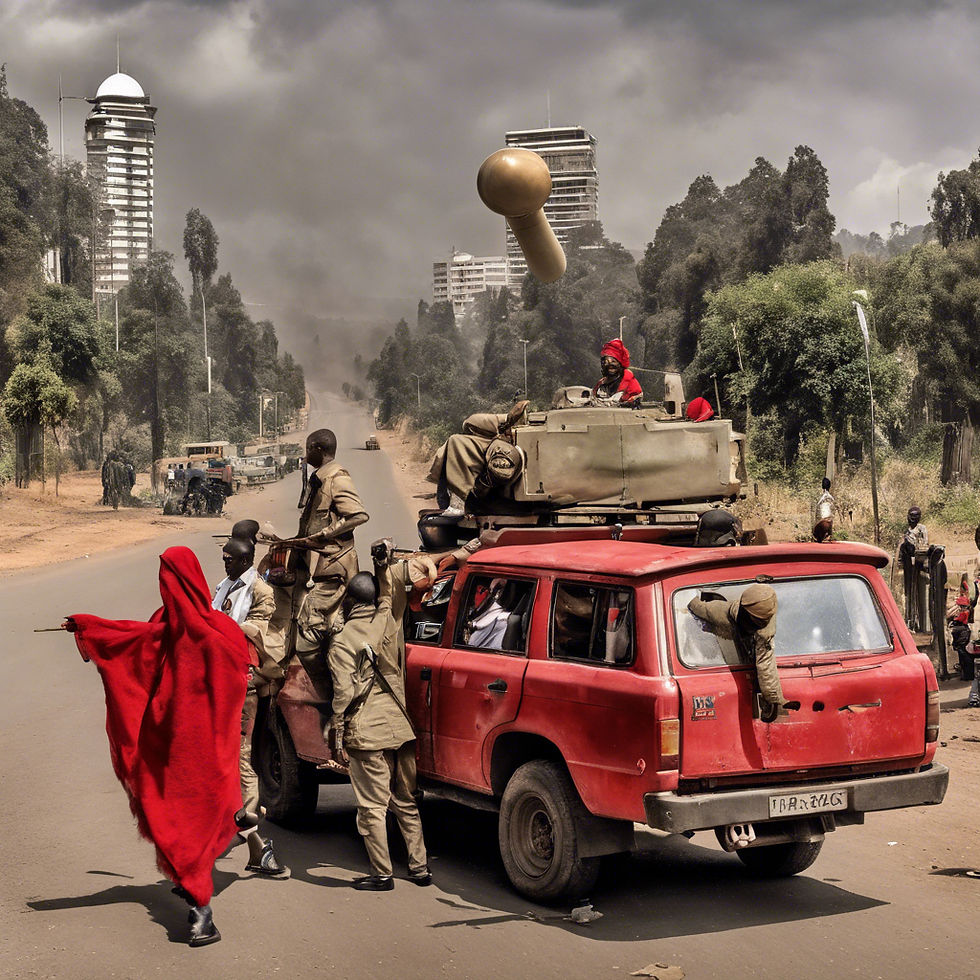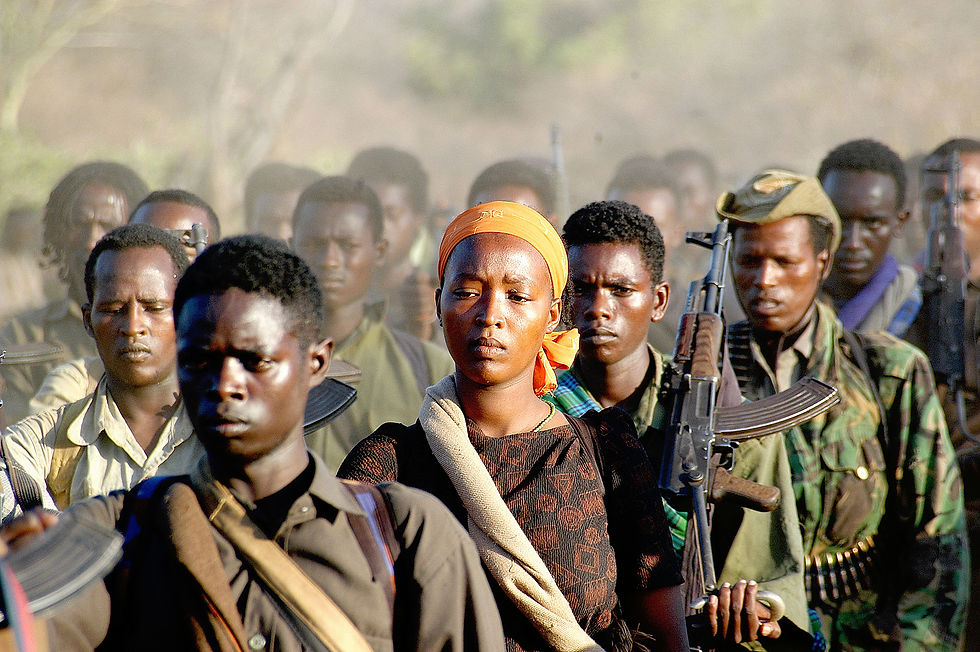Fifty years ago, Ethiopia witnessed a seismic shift in its political landscape with the overthrow of Emperor Haile Selassie, marking the end of an era and the supposed beginning of a new promising chapter in its history. This event took place 50 years ago today- on September 12, 1974. It had far-reaching consequences that were not obvious to the army members of the communist coup that actually toppled the monarchy nor by the student led movement for equality that was waiting in line for its turn. Now, to do justice to the legacy of HIM Haile Selassie it is important to take a step back and analyse the context in which he reigned and the country that he had inherited. When Haile Selassie ascended to the throne in 1930, the Ethiopia he inherited from his predecessor, Empress Zewditu, and from the legacy of Emperor Menelik II, was a nation in transition, facing a complex web of internal and external challenges. While Ethiopia had managed to retain its sovereignty during the infamous "Scramble for Africa" by colonial powers, it was far from stable or cohesive.
The country was marked by a number of structural and socio-political challenges that would test Haile Selassie’s capacity for leadership, reform, and diplomacy throughout his reign. Under Emperor Menelik II, Ethiopia had solidified its status as a sovereign African nation by defeating the Italians at the Battle of Adwa in 1896. This victory secured Ethiopia’s independence at a time when almost the entire African continent was being colonized. However, despite this monumental triumph, Ethiopia remained an agrarian, feudal society with a deeply hierarchical social structure, a decentralized system of governance, and significant ethnic diversity. The political landscape Haile Selassie inherited was a fragmented one, where regional warlords or Rases held immense power over their respective domains. While Menelik had expanded the Ethiopian empire and brought peripheral regions under the rule of the central monarchy, this integration was often superficial, with local chieftains and aristocrats maintaining considerable autonomy. Power was heavily decentralized, and the monarchy’s authority was far from absolute, but most importantly there was no sense of modern national identity in the Western sense; instead, the empire was a collection of loosely connected regions, where local allegiances often outweighed loyalty to the central government.

From an international perspective, Haile Selassie’s ascension came at a time when Ethiopia’s independence was under threat from colonial powers, particularly Italy. Mussolini’s fascist regime had ambitions to establish a colonial empire in Africa, and Ethiopia, surrounded by Italian-held territories such as Eritrea and Somalia, was a prime target. Haile Selassie understood the importance of international diplomacy in securing Ethiopia’s sovereignty. Early in his reign, he worked to improve Ethiopia’s foreign relations, joining the League of Nations in 1923, underlining Ethiopia’s status as a legitimate member of the global community. He sought military and economic assistance from abroad, knowing that the modern powers of Europe could play a crucial role in the defense of his empire. However, his diplomatic efforts were not enough to deter Italian aggression. In 1935, Mussolini launched a full-scale invasion of Ethiopia, resulting in the emperor’s exile in 1936. Haile Selassie’s dramatic speech at the League of Nations, where he appealed to the international community to intervene on Ethiopia’s behalf, remains one of the most famous moments of his reign. While the speech did not prompt immediate action, Haile Selassie’s return to power in 1941—with the help of British forces during World War II—solidified his reputation as a symbol of anti-colonial resistance.Haile Selassie’s early reign was marked by an ambitious program of modernization and centralization, as he sought to transform Ethiopia from a feudal, into a republican state.
He inherited a nation with significant challenges: a decentralized political system, an underdeveloped economy, ethnic and religious diversity, and the ever-present threat of colonial powers. The complexity of Ethiopia’s internal structure meant that Haile Selassie had to walk a delicate line between reform and tradition, often making compromises that would have long-term consequences for the country’s stability. His efforts to modernize and centralize Ethiopia met with both successes and failures, but his leadership during a time of great transformation left an indelible mark on the country’s history. The overthrow of Emperor Haile Selassie I in 1974 marked the end of nearly a millennium of continuous traditional rule in Ethiopia, plunging the country into a period of profound instability, violence, and political turmoil that would persist for decades. The regimes that succeeded the monarchy—each defined by ideological extremism, ethnic division, and authoritarian rule—failed to bring the stability, unity, or modernization that Haile Selassie had, for all his faults, worked to achieve. In stark contrast to the emperor’s reign, the post-monarchical governments of Ethiopia unleashed new forms of political repression, economic hardship, and civil conflict. The military junta known as the Derg (Amharic for "committee") took power in a coup that ousted Haile Selassie. Led initially by Mengistu Haile Mariam, the Derg promised a socialist transformation of Ethiopia and an end to so called feudal oppression. However, far from bringing an end to oppression, the Derg's reign was characterized by violent repression, ethnic cleansing, and brutal military campaigns.
The Derg: A Promise Turned into Dictatorship (1974-1991)
Mengistu’s rise to power saw the outbreak of the Red Terror, a violent campaign against perceived counter-revolutionaries and political opponents. Tens of thousands of Ethiopians were executed or disappeared under the Derg’s rule. The Red Terror created a culture of fear and deep divisions within Ethiopian society, undermining any hope of unity. Moreover, the Derg sought to impose Marxist-Leninist principles on a largely agrarian society, alienating many Ethiopians, particularly those in the rural regions who saw little benefit from the state’s collectivization policies. The brutal suppression of dissent, coupled with the Derg’s heavy-handed economic policies, exacerbated widespread poverty and discontent across the country. Ethiopia suffered several devastating famines during the Derg’s rule, the worst of which occurred between 1983 and 1985, leaving hundreds of thousands dead. The government’s policies of forced collectivization, displacement, and military campaigns against insurgents in the northern regions (particularly Tigray and Eritrea) exacerbated the food crisis. Mengistu’s regime often refused to acknowledge the scale of the famine or allow humanitarian aid to reach affected areas. The image of starving children broadcast globally became synonymous with Ethiopia during this period, deeply tarnishing the country’s international reputation.

Perhaps one of the most significant consequences of the Derg’s rule was the intensification of ethnic and regional conflicts. The regime waged a protracted war against Eritrean separatists, who sought independence from Ethiopia. The Eritrean People’s Liberation Front (EPLF), alongside the Tigray People’s Liberation Front (TPLF) and other insurgent groups, resisted the Derg's heavy-handed attempts to impose central control over historically minority groups. The Derg’s military campaigns were marked by atrocities and widespread human rights violations, further fueling resistance. Ultimately, the Derg’s inability to suppress the insurgencies and public discontent, coupled with its declining legitimacy and economic failures, led to its downfall in 1991 when rebel forces captured Addis Ababa, forcing Mengistu into exile in Zimbabwe.
The Ethiopian People's Revolutionary Democratic Front (EPRDF): Ethnic Federalism and Fragmentation (1991-2018)
Following the Derg’s collapse, the Ethiopian People’s Revolutionary Democratic Front (EPRDF), a coalition dominated by the TPLF, took control of the country. While the EPRDF brought an end to the Derg’s authoritarian socialism and promised a new era of democratic governance, its rule would prove highly contentious and marked by persistent instability. One of the most defining features of the EPRDF’s rule was its adoption of ethnic federalism as the governing model for Ethiopia. The 1994 constitution divided the country into ethnically-based federal states, granting significant autonomy to the regions. In theory, this was intended to resolve the ethnic tensions that had plagued Ethiopia during the DERG rule, by allowing different ethnic groups to self-govern and a false premise of preserving their cultures. False because Ethiopia's ethnic diversity had, of course, been preserved for millennia under the monarchy. In practice, ethnic federalism institutionalized ethnic divisions and exacerbated competition for power and resources along ethnic lines, essentially 'gamifying' the ideals equality. The TPLF's dominance over the EPRDF led to accusations of ethnic favoritism and political exclusion, particularly from the larger ethnic groups in the country. The system, instead of fostering national unity, deepened ethnic fragmentation and sowed the seeds for future conflicts.
Despite promises of democracy, the EPRDF maintained an authoritarian grip on power throughout its rule. Elections were often marred by accusations of fraud, voter intimidation, and repression of opposition parties. The government also controlled the media, restricted civil liberties, and cracked down on protests. One of the most significant uprisings occurred in 2016, where large-scale protests against land expropriation and political marginalization led to violent government crackdowns. The unrest spread across the country, leading to widespread anti-government demonstrations and increasing instability. While the EPRDF managed to secure a peace agreement with Eritrea in 1993, allowing the country to become an independent state, relations between the two countries remained strained. The Eritrean-Ethiopian War (1998-2000), a border conflict that claimed tens of thousands of lives, demonstrated the fragility of peace in the region.

In 2018, Abiy Ahmed—an Oromo politician—was appointed as prime minister after years of protests and internal pressure within the EPRDF coalition. Abiy's rise to power was initially seen as a moment of hope and optimism for Ethiopia, as he promised sweeping reforms to democratize the country, end ethnic violence, and unify the deeply divided society. One of Abiy Ahmed’s most significant early achievements was the peace deal with Eritrea in 2018, ending two decades of hostility. Despite this initial success, Abiy’s government was unable to end the violence. Ethnic violence surged across various regions and the government’s efforts to dismantle the EPRDF’s ethnic federalism model and replace it with a more centralized political system was met with resistance from regional leaders, particularly in Tigray. The tensions culminated in the outbreak of the Tigray War in 2020, when the TPLF, which had been sidelined by Abiy’s reforms, launched an armed rebellion against the central government. The conflict has since spiraled into a full-scale civil war, with reports of mass atrocities, famine, and war crimes.
In contrast Haile Selassie’s prosperous and stable reign, was highlighted by modernization projects that significantly improved Ethiopia's infrastructure such as roads, schools, hospitals, and telecommunications systems that were developed and expanded, fostering domestic connectivity and external trade. During his reign, the Ethiopian Birr (ETB) was one of the most stable currencies in Africa. In the post-war period, the currency was pegged to the U.S. dollar (USD) and maintained a favorable exchange rate. In fact, for much of the 1950s and 1960s, the birr traded at a rate of 2.5 ETB to 1 USD, signifying its strength compared to other currencies in the region. The prosperity and stability of the economy coupled with prudent fiscal management by the government contributed to maintaining the value of the currency during a turbulent period for the global economy. During the regimes that followed not only has the ETB almost defaulted but their tenure crippled by persistent instability both economic and political, ethnic violence, authoritarianism, and civil unrest. Each successive governments, from the Derg’s brutality to the EPRDF’s corruption and Abiy Ahmed’s degeneracy, have pit the country in perpetual turmoil. While HIM Haile Selassie faced his own set of challenges, his efforts to modernize Ethiopia and maintain its independence as well as tradition are in stark contrast to the internal disintegration and chaos that followed his fall. Fifty years after his ousting, Ethiopia’s very existence is at stake with the regime struggling to grapple with the legacies of the Ancient Society of Abyssinia that have defined its existence since time immemorial.

Comentários